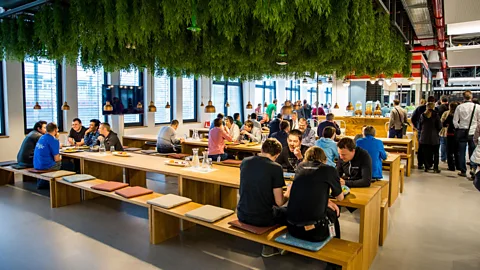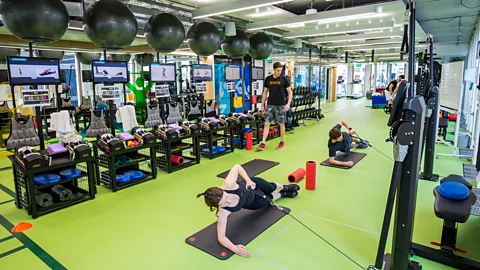What happens to workplace perks when no-one’s in the office?
 Alamy
AlamyDrinks on tap, rock-climbing walls, gourmet cafeterias – perks are a hallmark of many desirable workplaces. But when workers are not in the office to actually enjoy them, companies are being forced to reevaluate their incentives and work culture.
Greg Domino remembers the majestic views of New York City from his former company’s office on the seventy-second floor of a Financial District skyscraper. The view was one of many perks that the sports-streaming service afforded to office workers like him. Domino, a 33-year-old PR professional, recalls “these gorgeous panoramic views of New York, ping-pong tables, kombucha, often times breakfast”. Employees' Instagram Stories were flooded with images of their office trappings.
But when the office temporarily closed eight months ago due to the pandemic, Domino wasn’t wistful about losing his daily dose of corporate culture, the view or free kombucha. He relished working on simpler terms from his house for the first few months. And since being made redundant by the company in September, he’s realised he doesn’t want the fancy office back at all. “As the father of two small kids with a wife who also works," he says, "the flexibility of being home far outweighs [the office perks]”.
Over the past several years, more and more companies have been offering flashy amenities in the hope that it will help them compete for top talent. But with many corporate employees working from home since the start of the Covid-19 lockdowns, it’s unclear what purpose office spaces with ping-pong tables, espresso bars, meditation rooms and other enticing perks serve when there aren’t any employees in the building to use them.
 Alamy
AlamyThe souped-up workspace has its roots in Silicon Valley, and the dawn of the US technology industry. In the first half of the 20th Century, fledgling technology firms filled their offices with luxuries as a means of luring promising recruits.
“[Hewlett-Packard], founded [in] 1939, was the first born-in-the-Valley company to incorporate these perks,” according to Margaret O'Mara, a history professor at the University of Washington. “[They] included not only outdoor patios and recreational areas, but also stock options in a growing company. This set-up got the ball rolling, and the industry’s next wave of firms laid the foundation for what we know as today’s start-up vibe. “HP set the tone for the many companies that followed,” says O’Mara, “who took it to the next level in the 70s and 80s with jogging paths and swimming pools, and in the 90s and 2000s with free food and climbing walls and ping-pong tables.”
In more recent years, Silicon Valley giants and smaller firms alike have outfitted their offices with gyms, cocktail lounges and even a music rehearsal space and an Oval Office replica. Beyond being a recruitment incentive, amenities like this are meant to foster a palpable sense of company culture that sets certain companies apart from the herd.
The strategy has caught on beyond the confines of Big Tech. “Companies like Google were hugely influential for their much-heralded ‘Googley’ culture, play-at-work facilities and reputation of creative thinking,” says O’Mara. Companies across the corporate spectrum have followed Google’s lead, internalising “the idea that technological creation and creativity requires special amenity-rich settings”.
But cramming self-serve craft-beer taps or smiling baristas into a corporate backdrop doesn’t necessarily inspire a strong sense of shared culture. For one thing, “office culture” isn’t easily defined, says Marcella Bremer, a corporate consultant and author of the book Developing a Positive Culture Where People and Performance Thrive. Even with lavish amenities and mission statements plastered to an office wall, a company’s culture can still feel like a nebulous concept to rank-and-file workers. Regardless of the office perks or high-minded company rhetoric, Bremer says that culture is most inspired by “what people do and what leaders do and how teammates treat one another.”
Now, with scores of workers unable to play pool or sip cocktails at work, companies are reckoning with how to sustain that sense of culture. Ultimately, company culture is “relatively spontaneous and un-engineered”, says Rob Briner, a professor of organisational psychology at Queen Mary University, London. “If [perks] did have any value, and it’s possible that it did, the key thing is how do you replicate that” in a remote-working world.
 Alamy
AlamyThe shift to remote working as a result of the pandemic has accentuated a growing suspicion that the novelty of perks had worn stale for many. Some data show that in practice employees favour these perks much less than employers want to offer them. A 2019 survey from flexible office-rental company Hana included responses from 1,000 US workers about what they value most in an office. It showed that only 26% of people considered using shared space a vital aspect of work, and just 30% enjoyed using office amenities.
“What Covid-19 has done more broadly has exposed existing fault lines” in the workplace paradigm, says Briner. “If you look at the uptake of flexible working, people were already starting to vote with their feet” prior to the pandemic.
Perks are “mostly symbolic and mostly about image”, adds Briner. “I think it was more of an image thing to look attractive, to look cool.” They may have helped with recruitment, but other measurable benefits are less concrete – and, in some cases, detrimental as some companies used these perks to try to keep workers at the office longer.
And for some employees, it took the pandemic to help them realise that many perks could be superfluous. Rachel Forray, a 26-year-old product manager in New York City, used to work in an office with “a game room, a meditation room and... cold brew on tap”. But since the company migrated offline, she now realises that personal autonomy overrides her former office’s luxury. Working from home gives her more ownership over her day, she says. “There’s little things... like today, over lunchtime, I met with a few friends and did yoga for 20 minutes. Those are the types of things that I would never be able to do if I was constrained to the office.”
Workers like Forray are now finding unlikely allies in corporate leaders, some of whom are also questioning the utility of tricked-out offices. “I was an everyday-in-the office kind of guy, and it felt like that was how I’d build culture and connectivity between myself and the team,” says Simon Berg, the CEO of software platform Ceros. Despite building Ceros’ New York City office with charming decor and a variety of perks, such as a full-on English pub and a bookshelf that doubles as a secret door to a meeting room, Berg is determined to keep the office lights switched off more than ever before.
Now that Berg is able to spend more time with his family, he wants the company culture to hinge on allowing employees more “autonomy, mastery and freedom in their life”. When restrictions are lifted and workplaces deemed safe, Berg says the office will be used sparingly for “hyper-impactful and very focused” collaboration, but it won’t be mandatory to commute in.
“I think [the pandemic] is accelerating the autonomy and flexibility that people really want”, from a work-at-home environment, says Bremer, the corporate consultant. “People want more flexibility and personal autonomy at work. They might get more of this thanks to Covid-19.”
 Alamy
AlamyFor all of the feeling that perks are unnecessary, moving away from them can still create some challenges for fostering work culture. Whether or not you think it’s clichéd, gathering around a foosball table provides at least some benefits.
Briner says traditional office spaces thrive off a certain organic social atmosphere, in which casual conversation breeds rapport and occasional creative sparks between employees. “It’s quite difficult to replicate that [team culture] online,” says Briner, but companies are still cultivating ways to make the company’s influence more tangible, even with workers sitting at home.
When her company initially switched to online work, Forray, the product manager, got a daily $20 stipend for catered lunch. “I like how that still fits in with the perk but gives you a lot of freedom with how you use it,” she says.
Workers such as PR professional Domino are also more inclined to savour the convenience of personal control over their daily lives, even if it means the end of hip offices with breathtaking city views. “What else can they offer as a perk at this point? The only thing that you can really offer as a perk in this current environment is flexibility.”
Leaders like Berg now understand this demand more than ever. With an emphasis on flexibility, he says, workers “will be more connected to the company, more connected to their colleagues and more likely to produce better results, have more fun, be more creative and make more impact”. And, according to Briner, falling back on some of those traditional perks after workplace restrictions are lifted could be seen by workers as “even more superficial, a waste of money and tokenistic”.
Post-pandemic, the best office perk may be somewhat ironic: the ability to spend more time outside the office than ever before.
